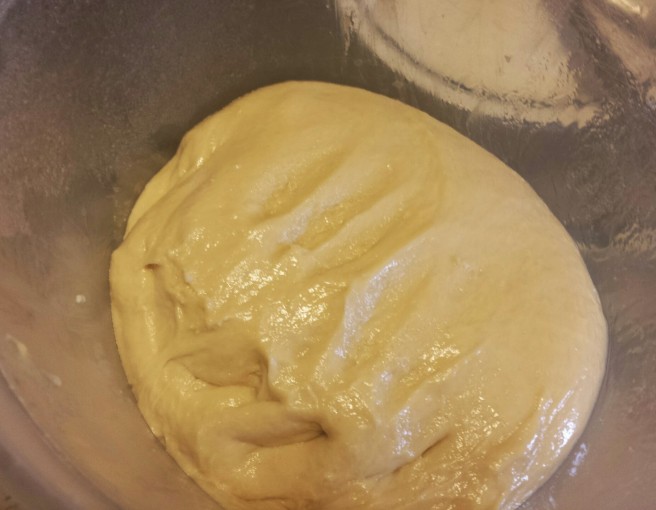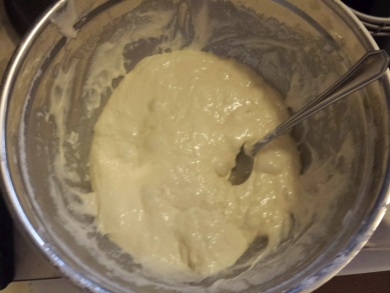“And the Lord said onto Moses. Hearken, O Moses for ye shall take for yourself bread which hath been leavened, and a key shall be placed upon it…”
– Levitironomy 12:43
“R’ Akiva said in the name of the Rabbis, When the verse states “a key shall be placed upon it” the verse means the challah should be in the shape of a key. R’ Meir said: in Pumpadeesah I once saw a man place a key inside of a regular bread, and said that he was placing a key upon it, therefore what the verse means, is to just place a key inside of the bread”
– Tractate Bava Gedola 12b
“On the Shabbos following Pesach, one must make a challah either in the shape of a key, or with a key placed inside. Men of faith will follow both opinions, and make a challah in the shape of a key with a key on the inside.
– Machmanodies Sefer Hamitzvos
Ok, as you can clearly see the meforshim talk about shlissel challah, and actually there’s a Shita M’Fursemmes that discusses the Machmanodies, and compares it to mezuza (how going l’fi two da’os is actually going like neither), but we don’t have time for that.
Annnnyway, enough leytzanus (and apologies to whoever is still reading and has no idea what just happened)…let’s talk about challah.
As I’m sure you no doubt remember, we’ve covered challah before, but I’m here to tell you, I’ve uncovered the key to making challah, want to hear what it is?? Get a scale.
Maybe you’ve heard this diatribe a few million times whilst here in this weblog, the whole scale thing, and I’m fairly certain I’ve convinced a grand total of -4 people to buy a scale (yes, that means 4 people returned theirs…probably out of spite…you spiteful bunch), but seriously, what if I could give you a master formula that can be scaled up and down as needed to make challah? Well guess what fellow internerds, I’ve got you covered. So get a freakin scale already, like f’realzies.
Ok so here’s the master ratio for Challah, taken once again by Peter Reinhart’s book Crust and Crumb:
| flour | 100% |
| water | 38% |
| eggs | 21% |
| oil | 6.25 |
| sugar | 12.5 |
| salt | 1.6 |
| yeast | 1.4 |
So we’ve spoken about baker’s percentages before, but to reiterate, here’s the general gist: all amounts are in proportion to the flour present, so the amount of flour is always denoted as 100%, and then all of the other percentages are the percent of that specific thing, in relation to the flour. So if you had 100 grams of flour, then you would need 38 grams of water, 21g of eggs, 6.25g of oil, and so on. I think you can see here why a scale makes this so much easier. All you need is one constant, so say you have 4 eggs, and want to make challah with that, well 4 eggs usually is in the 200 grams range (@ 50g per large egg), well from there we know, you would need 952 grams of flour, 361 grams of water, 60g of oil, and so on.

Now these numbers are fairly constant, but say you wanted to add more yolks (say you wanted a yellower challah, or wanted to boost the shelf life by increasing amount of fat and emulsification, etc…) well keep the 21% but adjust it to include yolks. Want to do some coconut oil with the oil (you know, because coconut oil is a saturated fat, which will lend more structure, and more flavor), same idea…keep the % the same, but adjust as needed. Want to make your challah with beer instead of water??? Well that probably means you have a problem , but hey I’d join you in that most wonderful problem! [and no, the alcohol, doesn’t get “fully cooked off”…and yes, it might affect the gluten formation because of the alcohol, but don’t you bust my bubble!] The options are limitless.

Oh and one last thing, pretty much whenever I make bread, and I have the time, I like to “ferment” my dough. Now terminology aside, what I mean by that is, basically allowing the dough to rise verrrry slowly, so the yeast, flour, and enzymes have time to develop stuff (basically flavors, but also it affects the quality of the dough, brings out certain sugars, enhances browning, enhances gluten formation…that sorta stuff), the way we do that is to have the dough rise in the fridge. Now you can do that one of a few ways, the easiest way to do that is combine all your ingredients, and after kneading, place in the fridge to rise for up to 4 days (punching down and redistributing the gases every once in a while). Another way to do this is by making a poolish or a biga. Those are both pretty similar things, and what you do essentially is combine some flour and water (You want more water than flour, so in the order of 100-120% water [actually the difference between a biga and a poolish are the amounts of water, but I digress]) mix until combined, and let it sit in the fridge for up to 4 days (again, mixing every once in a while). Once you have your poolish/biga thingamabob, you then add it together with the rest of your dough, and complete the challah making process (obviously accounting for the amounts of water/flour in the biga).

pardon the horrendous quality of the picture
Now we didn’t even discuss kneading, and forming dough, but we’ll leave that for the next time I decide to write about dough.
So there you have it! As a God fearing individual, I assume you will take it upon yourself to be m’kayim this mitzvas asey shel z’man grama of shlissel challah (oh and by the way, there are some shitas that say you can’t be yotzey if your wife makes it because she’s patur from this mitzva)
